Whirlpool WGTLV27HW, WGT4027HW, WETLV27HW, WET4124HW, WET4027HW User Manual
...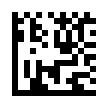
24" (61 cm) Electric & 27" (69 cm) Electric and Gas Washer/Dryer Installation Instructions
Instructions pour l’installation de la laveuse/sécheuse électrique de 24" (61 cm) et électrique et à gaz de 27" (69 cm)
Instrucciones de instalación de la lavadora/secadora eléctrica de 24" (61 cm) y eléctrica y de gas de 27" (69 cm)
Table of Contents |
|
Table des matières |
|
WASHER/DRYER SAFETY............................................................................... |
2 |
SÉCURITÉ DE LA LAVEUSE/SÉCHEUSE..................................................... |
36 |
INSTALLATION REQUIREMENTS................................................................... |
5 |
EXIGENCES D’INSTALLATION...................................................................... |
39 |
LOCATION REQUIREMENTS.......................................................................... |
7 |
EXIGENCES D’EMPLACEMENT ................................................................... |
41 |
DIMENSIONS/CLEARANCES, 27" (69 CM) MODELS.................................... |
8 |
DIMENSIONS/DISTANCES DE DÉGAGEMENT, |
|
DIMENSIONS/CLEARANCES, 24" (61 CM) MODELS................................... |
9 |
MODÈLES DE 27" (69 CM)............................................................................. |
42 |
DRAIN SYSTEM.............................................................................................. |
10 |
DIMENSIONS/DISTANCES DE DÉGAGEMENT, |
|
ELECTRICAL REQUIREMENTS, 240V ELECTRIC MODELS – U.S.A........... |
11 |
MODÈLES DE 24" (61 CM)............................................................................. |
43 |
ELECTRICAL REQUIREMENTS, 120V ELECTRIC MODELS – U.S.A. |
|
SYSTÈME DE VIDANGE................................................................................. |
44 |
AND CANADA (24" [61 CM] MODELS ONLY)............................................... |
12 |
SPÉCIFICATIONS ÉLECTRIQUES, MODÈLES ÉLECTRIQUES |
|
ELECTRICAL REQUIREMENTS, 240V ELECTRIC MODELS – CANADA..... |
12 |
DE 120V (MODÈLES DE 24" [61 CM] UNIQUEMENT – CANADA............... |
45 |
ELECTRICAL REQUIREMENTS, GAS MODELS |
|
SPÉCIFICATIONS ÉLECTRIQUES, MODÈLES ÉLECTRIQUES |
|
(27" [69 CM] MODELS ONLY)........................................................................ |
13 |
DE 240V – CANADA........................................................................................ |
45 |
GAS SUPPLY REQUIREMENTS, GAS MODELS |
|
SPÉCIFICATIONS ÉLECTRIQUES, MODÈLES À GAZ |
|
(27" [69 CM] MODELS ONLY)........................................................................ |
13 |
(MODÈLES DE 27" [69 CM] UNIQUEMENT)................................................. |
46 |
REMOVE FOAM PACKING (24" [61 CM] MODELS)..................................... |
14 |
SPÉCIFICATIONS DE L’ALIMENTATION EN GAZ, MODÈLES À GAZ |
|
ELECTRICAL CONNECTION, 27" (69 CM) ELECTRIC MODELS |
|
(MODÈLES DE 27" [69 CM] UNIQUEMENT)................................................. |
47 |
(U.S.A. ONLY).................................................................................................. |
15 |
ENLEVER L’EMBALLAGE EN MOUSSE (MODÈLES DE 24" [61 CM])........ |
48 |
ELECTRICAL CONNECTION, 24" (61 CM) 240V ELECTRIC MODELS |
|
ÉVACUATION.................................................................................................. |
49 |
(U.S.A. ONLY).................................................................................................. |
21 |
RACCORDEMENT DU TUYAU DE VIDANGE............................................... |
52 |
VENTING ........................................................................................................ |
25 |
RACCORDEMENT DES TUYAUX D’ARRIVÉE D’EAU.................................. |
53 |
CONNECT DRAIN HOSE................................................................................ |
28 |
RACCORDEMENT À LA CANALISATION DE GAZ |
|
CONNECT INLET HOSES.............................................................................. |
29 |
(MODÈLES À GAZ DE 27" [69 CM] UNIQUEMENT)..................................... |
54 |
MAKE GAS CONNECTION (GAS 27" [69 CM] MODELS ONLY).................. |
30 |
RACCORDEMENT DU CONDUIT D’ÉVACUATION...................................... |
55 |
CONNECT VENT............................................................................................. |
31 |
ÉTAPES D’INSTALLATION FINALES............................................................. |
56 |
FINAL INSTALLATION STEPS....................................................................... |
32 |
LISTE DE VÉRIFICATION POUR L’ACHÈVEMENT |
|
COMPLETE INSTALLATION CHECKLIST..................................................... |
35 |
DE L’INSTALLATION....................................................................................... |
59 |
Índice
SEGURIDAD DE LA LAVADORA/SECADORA.............................................. |
60 |
QUITE EL EMBALAJE DE HULE ESPUMA (MODELOS DE 24" [61 CM]) |
....73 |
REQUISITOS DE INSTALACIÓN.................................................................... |
63 |
CONEXIÓN ELÉCTRICA, MODELOS ELÉCTRICOS |
|
REQUISITOS DE UBICACIÓN....................................................................... |
65 |
DE 27" (69 CM) (EE.UU. SOLAMENTE)......................................................... |
74 |
DIMENSIONES Y ESPACIOS LIBRES, MODELOS DE 27" (69 CM)............ |
66 |
CONEXIÓN ELÉCTRICA, MODELOS ELÉCTRICOS |
|
DIMENSIONES Y ESPACIOS LIBRES, MODELOS DE 24" (61 CM)............ |
67 |
DE 24" (61 CM) DE 240V (EE.UU. SOLAMENTE).......................................... |
80 |
SISTEMA DE DESAGÜE................................................................................. |
68 |
VENTILACIÓN................................................................................................. |
84 |
REQUISITOS ELÉCTRICOS, MODELOS ELÉCTRICOS DE 240V............... |
69 |
CONECTE LA MANGUERA DE DESAGÜE................................................... |
87 |
REQUISITOS ELÉCTRICOS, MODELOS ELÉCTRICOS DE 120V |
|
CONECTE LAS MANGUERAS DE ENTRADA............................................... |
88 |
(MODELOS DE 24" [61 CM] SOLAMENTE).................................................. |
70 |
CONEXIÓN DEL SUMINISTRO DE GAS (MODELOS A GAS |
|
REQUISITOS ELÉCTRICOS, MODELOS A GAS |
|
DE 27" [69 CM] SOLAMENTE)....................................................................... |
89 |
(MODELOS DE 27" [69 CM] SOLAMENTE).................................................. |
71 |
CONECTE EL DUCTO DE ESCAPE............................................................... |
90 |
REQUISITOS DEL SUMINISTRO DE GAS, MODELOS A GAS |
|
PASOS FINALES DE INSTALACIÓN.............................................................. |
91 |
(MODELOS DE 27" [69 CM] SOLAMENTE).................................................. |
72 |
LISTA DE CONTROL PARA LA REALIZACIÓN |
|
|
|
DE LA INSTALACIÓN..................................................................................... |
94 |
INSTALLATION NOTES |
NOTES CONCERNANT L’INSTALLATION |
|
Date of purchase: _________________________________________ |
Date d’achat :_____________________________________________ |
|
Date of installation:________________________________________ |
Date d’installation :________________________________________ |
|
Installer:__________________________________________________ |
Installateur : ______________________________________________ |
|
Model number:____________________________________________ |
Numéro de modèle :_______________________________________ |
|
Serial number: ____________________________________________ |
Numéro de série : _________________________________________ |
|
NOTAS DE INSTALACIÓN |
|
|
Fecha de la compra:_______________________________________ |
|
|
Fecha de la instalación:____________________________________ |
|
|
Instalador:_ _______________________________________________ |
|
|
Número de modelo: _______________________________________ |
|
|
Número de serie:__________________________________________ |
W11028718A |
|
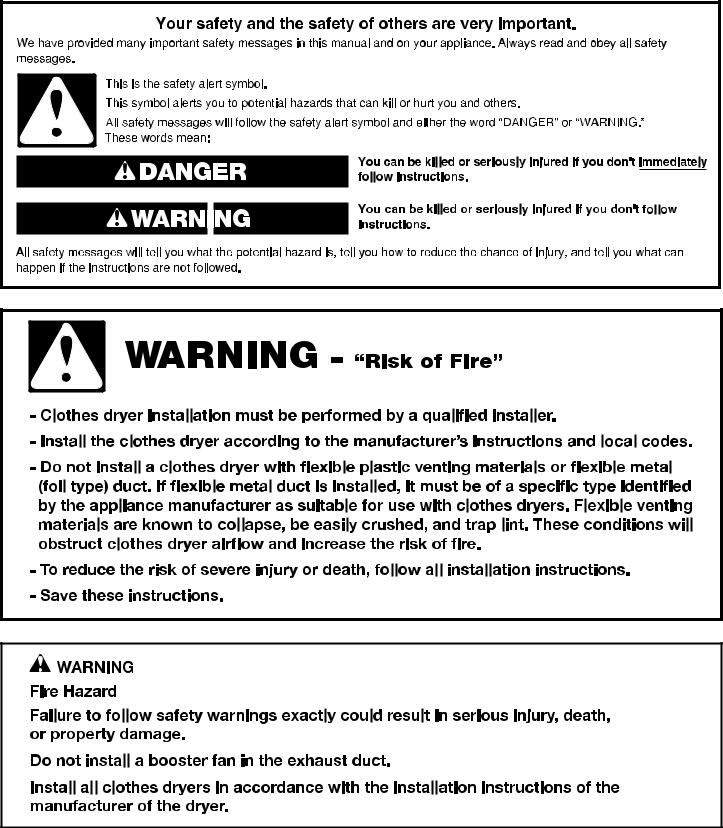
Washer/Dryer Safety
2

 WARNING:
WARNING:
FIRE OR EXPLOSION HAZARD
Failure to follow safety warnings exactly could result in serious injury, death, or property damage.
–Do not store or use gasoline or other flammable vapors and liquids in the vicinity of this or any other appliance.
–WHAT TO DO IF YOU SMELL GAS:
•Do not try to light any appliance.
•Do not touch any electrical switch; do not use any phone in your building.
•Clear the room, building, or area of all occupants.
•Immediatelyinstructions. call your gas supplier from a neighbor’s phone. Follow the gas supplier’s
•If you cannot reach your gas supplier, call the fire department.
–Installation and service must be performed by a qualified installer, service agency, or the gas supplier.
In the State of Massachusetts, the following installation instructions apply:
■Installations and repairs must be performed by a qualified or licensed contractor, plumber, or gas fitter qualified or licensed by the State of Massachusetts.
■Acceptable Shut-off Devices: Gas Cocks and Ball Valves installed for use shall be listed.
■A flexible gas connector, when used, must not exceed 4 feet (121.9 cm).
IMPORTANT: The gas installation must conform with local codes, or in the absence of local codes, with the National Fuel Gas Code, ANSI Z223.1/NFPA 54, or the Natural Gas and Propane Installation Code, CSA B149.1.
The dryer must be electrically grounded in accordance with local codes, or in the absence of local codes, with the National Electrical Code, ANSI/NFPA 70, or the Canadian Electrical Code, Part 1, CSA C22.1.
3
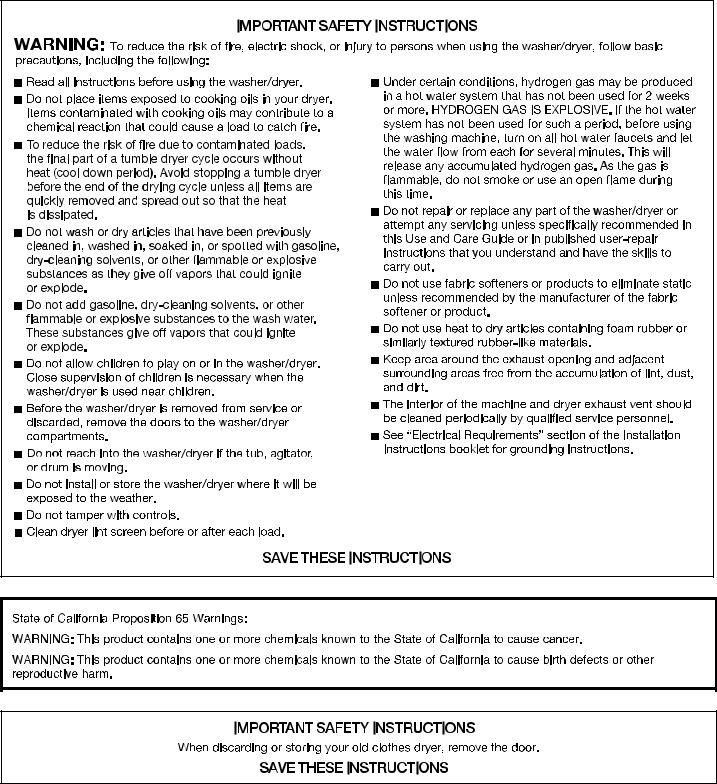
4
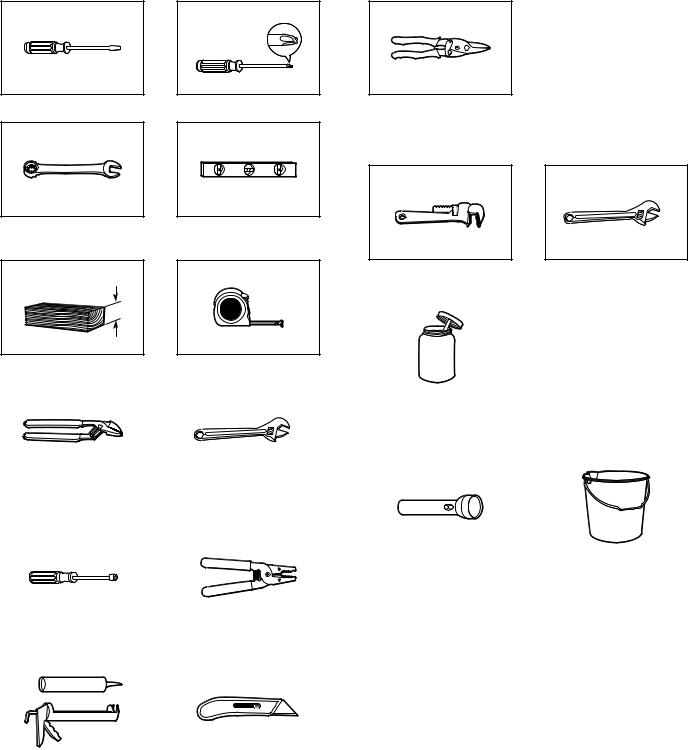
Installation Requirements
Tools and Parts
Gather required tools and parts before starting installation.
Tools needed:
Flat-blade screwdriver
Adjustable or open-end wrench 9/16" (14 mm)
4" min (102 mm)
#2 Phillips screwdriver
Level
Wood block |
Ruler or measuring tape |
|
|
|
|
|
|
|
Pliers that open to 19/16" |
|
Adjustable wrench that |
(39.5 mm) |
|
opens to 1" (25 mm) or |
|
|
hex-head socket wrench |
|
|
|
|
|
|
1/4" (6.5 mm) nut driver |
|
Wire stripper |
(recommended) |
|
|
|
|
|
|
|
|
Caulking gun and compound |
Utility knife |
|
|
(new vent installations) |
|
Tin snips (new vent installations)
Tools needed for gas installations:
8" (203 mm) or 10" |
8" (203 mm) or 10" |
(254 mm) pipe wrench |
(254 mm) adjustable wrench |
|
(for gas connections) |
|
|
|
|
Pipe-joint compound resistant to propane gas
Optional tools:
|
|
|
Flashlight |
|
Bucket |
5

Parts supplied:
NOTE: Remove parts package from the washer basket. Check that all parts were included.
Plastic strap
Silver double-wire hose clamp
Drain hose
Anti-tip brackets (2) and screws (4)
(27" [69 cm] models)
Parts needed: (Not supplied with washer/dryer)
νVent clamps
νVent elbows and ductwork
ν Mobile Home Installation Kit (Part Number 346764)
ν Metal exhaust system hardware
Inlet hoses with flat washers
Check local codes, electrical supply and venting, and read “Electrical Requirements” and “Venting Requirements” before purchasing parts. Mobile home installations require metal exhaust system hardware available for purchase from the dealer from whom you purchased your washer/dryer. For further information, please reference the “Assistance or Service” section of the Washer/Dryer Use and Care Guide.
Optional equipment: (Not supplied with washer/dryer)
Refer to your Use and Care Guide for information about accessories available for your washer/dryer.
Alternate parts: (Not supplied with washer/dryer)
Your installation may require additional parts. To order, please refer to the toll-free numbers on the back page of your Use and Care Guide.
If you have: |
You will need: |
Overhead sewer |
Standard 20 gal. (76 L) 39" (991 mm) |
|
tall Drain Tub or Utility Sink, Sump |
|
Pump and Connectors (available from |
|
local plumbing suppliers) |
Floor drain |
Siphon Break Part Number 285320, |
|
Additional Drain Hose Part Number |
|
285702, and Connector Kit Part |
|
Number 285442 |
1" (25 mm) standpipe |
2" (51 mm) diameter to 1" (25 mm) |
|
diameter Standpipe Adapter |
|
Part Number 3363920, |
|
Connector Kit Part Number 285835 |
Laundry tub or |
Sump pump system (if not already |
standpipe taller than |
available) |
96" (2.4 m) |
|
Drain hose too short |
Extension Drain Hose |
|
Part Number 285863, |
|
Connector Kit Part Number 285835 |
Lint clogged drain |
Drain Protector Part Number 367031, |
|
Connector Kit Part Number 285835 |
Water faucets |
Two longer water fill hoses: |
beyond reach |
6 ft (1.8 m) Part Number 76314, |
of fill hoses |
10 ft (3.0 m) Part Number 350008 |
6
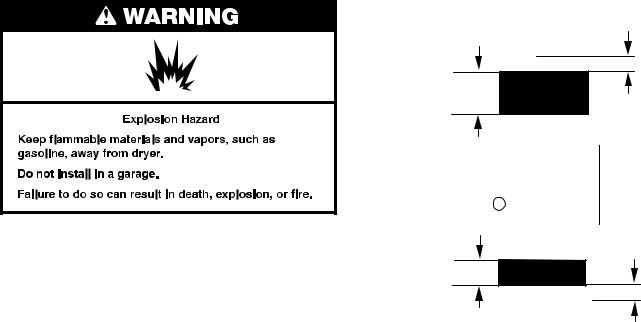
Location Requirements
Recessed area or closet installation
Select proper location for your washer/dryer to improve performance and minimize noise and possible “washer walk.” Install your washer/dryer in a basement, laundry room, closet, or recessed area.
You will need:
νA location that allows for proper exhaust installation. A washer/dryer must be exhausted to the outdoors. See “Venting Requirements.”
νFor 27" (69 cm) and 24" (61 cm) 240V electric models, a separate 30 amp circuit. For 24" (61 cm) 120V electric models, a separate 20 amp circuit. For gas models, a separate 120V 15 or 20 amp circuit.
νFor 27" (69 cm) electric models using a power supply cord, for 24" (61 cm) electric models, and for gas models, a grounded electrical outlet located within 2 ft (610 mm) of
either side of the washer/ dryer. See “Electrical Requirements.”
νA sturdy floor to support the washer/dryer weight (washer/ dryer, water, and load) of 500 lbs (226.8 kg).
νA level floor with a maximum slope of 1" (25 mm) under entire washer/dryer. Clothes may not tumble properly and automatic sensor cycles may not operate correctly if washer/dryer is not level. Installing on carpet is not recommended.
νA water heater set to deliver 120°F (49°C) water to the washer.
νHot and cold water faucets located within 4 ft (1.2 m) of the hot and cold water fill valves, and water pressure of 5–100 psi (34.5–689.6 kPa).
The washer/dryer must not be installed or stored in an area where it will be exposed to water and/or weather.
Do not operate your washer in temperatures at or below 32ºF (0ºC). Some water can remain in the washer and can cause damage in low temperatures. See “Washer/Dryer Care” in the Washer/Dryer Use and Care Guide for winterizing information.
Do not operate your dryer at temperatures below 45°F (7°C). At lower temperatures, the dryer might not shut off at the end of an automatic cycle. This can result in longer drying times.
Check code requirements. Some codes limit, or do not permit, installation of the washer/dryer in garages, closets, mobile homes, or sleeping quarters. Contact your local building inspector.
48 in.2
(310 cm2) 3"
(76 mm)
Front |
Closet |
View |
door |
|
|
3" (76 mm)
24 in.2
(155 cm2)
The spacing dimensions on the following pages are recommended for this washer/dryer. This washer/dryer has been tested for spacing of 0" (0 mm) clearance at the sides and back. Recommended spacing should be considered for the following reasons:
νAdditional spacing should be considered for ease of installation and servicing.
νAdditional clearances might be required for wall, door, and floor moldings.
νAdditional spacing on all sides of the washer/dryer is recommended to reduce noise transfer.
νFor closet installation, with a door, minimum ventilation openings in the top and bottom of the door are required. Louvered doors with equivalent ventilation openings are acceptable.
NOTE: For gas models, no other fuel-burning appliance can be installed in the same closet as the washer/dryer.
Mobile Home – Additional Installation Requirements
This washer/dryer is suitable for mobile home installations. The installation must conform to the Manufactured Home Construction and Safety Standard, Title 24 CFR, Part 3280 (formerly the Federal Standard for Mobile Home Construction and Safety, Title 24, HUD Part 280) or the Canadian Manufactured Home Standard, CAN/CSA-Z240 MH.
Mobile home installations require:
νMetal exhaust system hardware, which is available for purchase from your dealer.
νMobile Home Installation Kit Part Number 346764 (gas models only). See “Tools and Parts” for ordering information.
νSpecial provisions must be made in mobile homes to introduce outside air into the dryer. The opening (such as a nearby window) should be at least twice as large as the dryer exhaust opening.
7
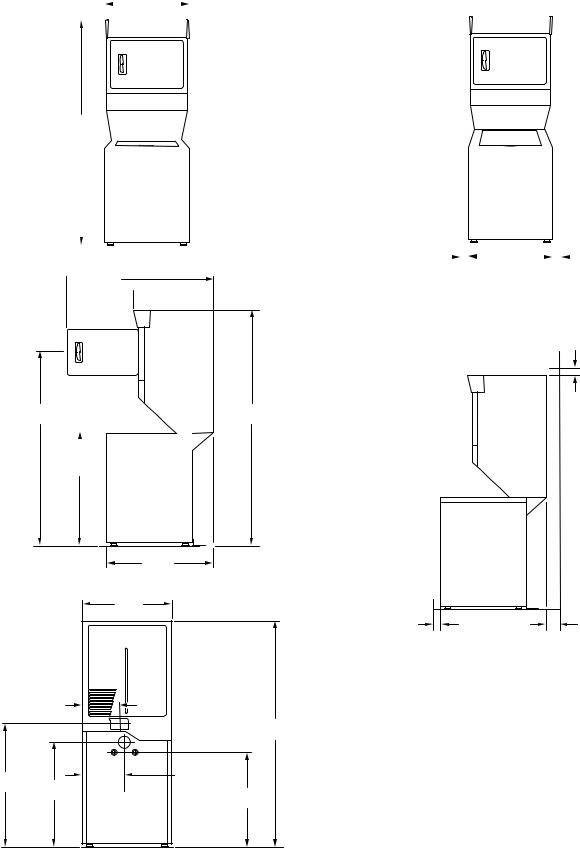
Dimensions/Clearances, 27" (69 cm) Models
Dimensions |
|
|
|
|
Clearances |
||||
Front View |
|
271/4" |
|
|
Side Clearances (recommended/minimum) |
||||
|
|
|
|
|
|
|
|
|
|
|
|
|
|
|
|
|
|
||
|
|
|
(692 mm) |
|
|
|
|||
|
|
|
|
|
|
|
|
|
|
75½" (1918 mm)
|
|
|
|
|
|
|
|
|
|
|
|
|
|
|
|
|
|
|
|
|
|
|
|
|
|
|
|
|
|
|
|
|
|
|
|
|
|
|
|
|
|
|
|
|
|
|
|
|
|
|
|
|
|
|
|
|
|
|
|
|
|
|
|
|
|
|
|
|
|
|
|
|
|
|
|
|
|
|
|
|
|
|
|
|
|
|
|
|
|
|
|
|
|
|
|
|
|
|
|
|
|
|
|
|
|
|
|
|
|
|
|
|
|
|
|
|
|
|
|
|
|
|
|
|
|
|
|
|
|
|
|
|
|
|
|
|
|
|
|
|
|
|
|
|
|
|
|
|
|
|
|
|
|
|
|
|
|
|
|
Side View |
1"/0" |
|
|
|
|
|
|
|
|
|
|
|
|
|
1"/0" |
||||||||||||||||
|
|
|
|
|
|
|
(25 mm/0 mm) |
|
|
|
|
|
|
|
|
|
|
|
|
(25 mm/0 mm) |
|||||||||||
|
|
|
|
|
|
|
|
|
|
|
|
|
|
|
|
|
|
|
|
||||||||||||
 4715/16"
4715/16"
(1218 mm)  2711/16"
2711/16" (704 mm)
(704 mm)
Front/Back/Top Clearances (recommended/minimum)
1"/0"
(25 mm/0 mm)
6113/16" |
|
|
|
75½" |
||
(1570 mm) |
|
|
(1918 mm) |
|||
|
|
|
|
|
|
|
|
|
|
|
|
|
|
|
|
|
|
|
|
|
|
|
|
|
|
|
|
35¾" (908 mm)
|
|
327/16" |
|
|
|
(824 mm) |
|
Back View |
|
271/4" |
|
|
|
|
|
|
|
(692 mm) |
|
|
|
1" |
5" |
|
|
(25 mm) |
(127 mm)** |
|
|
(Closet)* |
|
|
11½" |
|
|
|
(292 mm) |
75½" |
|
|
|
|
|
|
|
(1918 mm) |
|
|
|
13" |
|
45" |
39" |
(330 mm) |
|
(1143 mm) |
3615/16" |
|
|
|
(991 mm) |
|
|
|
|
(938 mm) |
|
*Required spacing.
**Rear clearance may be 0" (0 mm) when house exhaust system is lined up directly with dryer exhaust.
8

Dimensions/Clearances, 24" (61 cm) Models
Dimensions
Front View
237/8"
(607 mm)
Clearances
Side Clearances (recommended/minimum)
74¼" (1886 mm)
|
|
|
|
|
|
|
|
|
|
|
|
|
|
|
|
|
|
|
|
|
|
|
|
|
|
|
|
|
|
|
|
|
|
|
|
|
|
|
|
|
|
|
|
|
|
|
|
|
|
|
|
|
|
|
|
|
|
|
|
|
|
|
|
|
|
|
|
|
|
|
|
|
|
|
|
|
|
|
|
|
|
1"/0" |
|
|
|
|
|
|
|
|
|
|
|
|
|
|
|
|
1"/0" |
||||||||
|
|
|
|
|
(25 mm/0 mm) |
|
|
|
|
|
|
|
|
|
|
|
|
|
|
|
(25 mm/0 mm) |
|||||
|
|
|
|
|
|
|
|
|
|
|
|
|
|
|
|
|
||||||||||
Side View
 367/16"
367/16" (926 mm)
(926 mm)  20¾"
20¾" 
(527 mm)
|
|
|
|
|
|
|
|
|
|
|
|
|
|
|
|
|
|
|
|
|
|
|
|
|
|
|
|
|
|
|
|
|
|
|
|
|
|
|
|
|
|
|
|
|
|
|
|
|
|
|
|
|
|
|
|
|
|
|
|
|
|
|
|
|
|
|
|
|
|
|
|
|
|
|
|
|
|
|
|
|
|
|
|
|
|
|
|
|
|
|
|
|
|
|
|
|
|
|
|
|
|
|
|
|
|
|
|
|
|
|
|
|
|
|
|
|
|
|
|
62" |
|
|
|
|
|
74¼" |
|||||||||||||
(1575 mm) |
|
|
|
|
|
|
|
|
(1886 mm) |
||||||||||
|
|
|
|
|
|
|
|||||||||||||
|
|
|
|
|
|
|
|
|
|
|
|
|
|
|
|
|
|
|
|
|
|
|
|
|
|
|
|
|
|
|
|
|
|
|
|
|
|
|
|
|
|
|
|
|
|
|
|
|
|
|
|
|
|
|
|
|
|
|
|
|
|
|
3311/16" |
|
|
40¼" |
|
|
|||||||||||
|
|
|
(856 mm) |
|
|
|
|
|
|
(1022 mm) |
|
|
|||||||
|
|
|
|
|
|
|
|
|
|
|
|
|
|
|
|
|
|
|
|
|
|
|
|
|
|
|
|
|
|
|
|
|
|
|
|
|
|
|
|
|
|
265/8" |
|
Back View |
|
(676 mm) |
|
|
|
|
|
|
|
237/8" |
|
|
|
(607 mm) |
|
|
12" |
|
|
(305 mm) |
|
|
|
|
|
12" |
74¼" |
|
|
(1886 mm) |
|
|
|
(305 mm) |
|
|
|
|
|
475/8" |
401/8" |
|
|
(1210 mm) |
|
|
|
(1019 mm) |
3115/16" |
|
|
|
|
|
|
|
|
(811 mm) |
|
Front/Back/Top Clearances
|
12" |
|
(305 mm) |
1" |
5" |
(25 mm) |
(127 mm)** |
(Closet)* |
|
*Required spacing.
**Rear clearance may be 0" (0 mm) when house exhaust system is lined up directly with dryer exhaust.
9
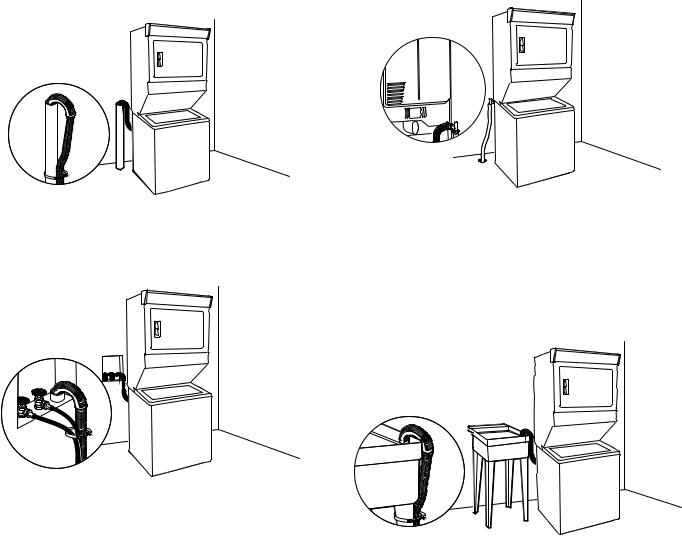
Drain System
Drain system can be installed using a floor drain, wall standpipe, floor standpipe, or laundry tub. Select method you need.
Floor standpipe drain system
Minimum diameter for a standpipe drain: 2" (51 mm). Minimum carry-away capacity: 17 gal. (64 L) per minute. Top of standpipe must be at least 39" (991 mm) high; install no higher than 96"
(2.4 m) from bottom of washer/dryer. If you must install higher than 96" (2.4 m), you will need a sump pump system.
Wall standpipe drain system
See requirements for floor standpipe drain system.
Floor drain system
Floor drain system requires a Siphon Break Kit (Part Number 285834), two Connector Kits (Part Number 285385), and an Extension Drain Hose (Part Number 285863) that may be purchased separately. To order, please see toll-free phone numbers in your Use and Care Guide. Minimum siphon break: 28" (710 mm) from bottom of washer/dryer. (Additional hoses may be needed.)
Laundry tub drain system
Minimum capacity: 20 gal. (76 L). Top of laundry tub must be at least 39" (991 mm) above floor on 27" (69 cm) models, or 34" (864 mm) above floor on 24" (61 cm) models; install no higher than 96" (2.4 m) from bottom of washer/dryer.
IMPORTANT: To avoid siphoning, no more than 4.5" (114 mm) of drain hose should be inside standpipe or below the top of wash tub. Secure drain hose with plastic strap.
10
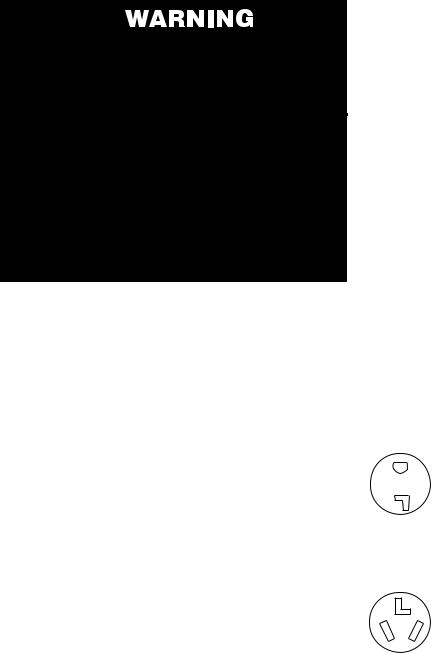
Electrical Requirements, 240V Electric Models – U.S.A.
νIt is recommended that a separate circuit breaker serving only this appliance be provided.
νTo minimize possible shock hazard, the cord must be plugged into a mating, 3 or 4 prong, grounding-type outlet, grounded in accordance with local codes and ordinances. If a mating outlet is not available, it is the personal responsibility and obligation of the customer to have the properly grounded outlet installed by a qualified electrician.
νIf codes permit and a separate ground wire is used, it is recommended that a qualified electrician determine that the ground path is adequate.
νCheck with a qualified electrician if you are not sure the washer/dryer is properly grounded.
νDo not have a fuse in the neutral or ground circuit.
It is your responsibility:
νTo contact a qualified electrical installer.
νTo be sure that the electrical connection is adequate and in conformance with the National Electrical Code, ANSI/NFPA 70 – latest edition and all local codes and ordinances.
A copy of the above code standards can be obtained from: National Fire Protection Association, One Batterymarch Park, Quincy, MA 02269.
νTo supply the required 3- or 4-wire, single phase, 120/240 volt, 60 Hz., AC only electrical supply (or 3- or 4-wire, 120/208 volt electrical supply, if specified on the serial/rating plate) on a separate 30 amp circuit, fused on both sides of the line. A time-delay fuse or circuit breaker is recommended. Connect to an individual branch circuit.
νDo not use an extension cord.
Electrical Connection
To properly install your washer/dryer, you must determine the type of electrical connection you will be using and follow the instructions provided for it here.
νThis washer/dryer is manufactured ready to install with a 3-wire electrical supply connection. The neutral ground wire is permanently connected to the neutral conductor (white wire) within the dryer. If the dryer is installed with a 4-wire electrical supply connection, the neutral ground wire must be removed from the external ground connector (green screw), and secured under the neutral terminal (center or white wire) of the terminal block. When the neutral ground wire is secured under the neutral terminal (center or white wire) of the terminal block, the dryer cabinet is isolated from the neutral conductor.
νIf local codes do not permit the connection of a neutral ground wire to the neutral wire, see “Optional 3-wire connection” in the “Electrical Connection” section.
νA 4-wire power supply connection must be used when the appliance is installed in a location where grounding through the neutral conductor is prohibited. Grounding through the neutral is prohibited for (1) new branch-circuit installations,
(2) mobile homes, (3) recreational vehicles, and (4) areas where local codes prohibit grounding through the neutral conductors.
If using a power supply cord:
Use a UL Listed power supply cord kit marked for use with clothes dryers. The kit should contain:
νA UL Listed 30 amp power supply cord, rated 120/240 volt minimum. The cord should be type SRD or SRDT and be at least 4 ft (1.22 m) long. The wires that connect to the dryer must end in ring terminals or spade terminals with upturned ends.
νA UL Listed strain relief.
If your outlet looks like this:
|
|
|
|
|
Then choose a 4-wire power supply cord with ring |
|
|
|
|
|
or spade terminals and UL Listed strain relief. The |
|
|
|
|
|
4-wire power supply cord, at least 4 ft (1.22 m) |
|
|
|
|
|
long, must have four 10-gauge copper wires and |
|
|
|
|
|
|
|
|
|
|
|
match a 4-wire receptacle of NEMA Type 14-30R. |
|
|
4-wire |
The ground wire (ground conductor) may be either |
||
|
|
green or bare. The neutral conductor must be |
|||
receptacle |
|||||
|
(14-30R) |
identified by a white cover. |
|||
If your outlet looks like this:
Then choose a 3-wire power supply cord with ring or spade terminals and UL Listed strain relief. The
3-wire power supply cord, at least 4 ft (1.22 m) long, must have three 10-gauge copper wires and match a 3-wire receptacle of NEMA Type 10-30R.
3-wire receptacle (10-30R)
If connecting by direct wire (27" [69 cm] models only):
Power supply cable must match power supply (4-wire or 3-wire) and be:
νFlexible armored cable or nonmetallic sheathed copper cable (with ground wire), covered with flexible metallic conduit. All current-carrying wires must be insulated.
ν10-gauge solid copper wire (do not use aluminum).
νAt least 5 ft (1.52 m) long.
11

Electrical Requirements,
240V Electric Models – Canada
Electrical Requirements, 120V Electric Models – U.S.A. and Canada (24" [61 cm] Models Only)
nIt is recommended that a separate circuit breaker serving only this appliance be provided.
n120V models are equipped with a power supply cord having a 3 prong grounding plug intended
to be plugged into a 20 amp 5-20R wall receptacle.
n To minimize possible shock hazard, the cord must be plugged into a mating, 3 prong, grounding-type outlet, grounded in accordance
with local codes and ordinances. If a mating outlet is not available, it is the personal responsibility and obligation
of the customer to have the properly grounded outlet installed by a qualified electrician.
nIf codes permit and a separate ground wire is used, it is recommended that a qualified electrician determine that the ground path is adequate.
nCheck with a qualified electrician if you are not sure the washer/dryer is properly grounded.
nDo not have a fuse in the neutral or ground circuit.
n120 volt, 60 Hz, AC only, 20 amp fused electrical supply is required. A time-delay fuse or circuit breaker is recommended.
It is your responsibility:
nTo contact a qualified electrical installer.
nTo be sure that the electrical connection is adequate and in conformance with the National Electrical Code, ANSI/NFPA 70 – latest edition or the Canadian Electrical Code, C22.1 – latest edition and all local codes and ordinances.
A copy of the above code standards can be obtained from: National Fire Protection Association, One Batterymarch Park, Quincy, MA 02269 or Canadian Standards Association, 178 Rexdale Blvd., Toronto, ON M9W 1R3 CANADA.
nDo not use an extension cord.
It is your responsibility:
■■To contact a qualified electrical installer.
■■To be sure that the electrical connection is adequate and in conformance with Canadian Electrical Code, C22.1 – latest edition and all local codes. A copy of above codes standard may be obtained from: Canadian Standards Association, 178 Rexdale Blvd., Toronto, ON M9W 1R3 CANADA.
■■To supply the required 4-wire, single-phase, 120/240 volt, 60 Hz, AC only electrical supply on a separate 30 amp circuit, fused on both sides of the line. A time-delay fuse
or circuit breaker is recommended. Connect to an individual branch circuit.
■■This dryer is equipped with a UL Listed and/or CSA International Certified Power Cord intended to be plugged into a standard 14-30R wall receptacle. The cord is 5 ft. (1.52 m) long. Be sure wall receptacle is
within reach of dryer’s final location. 4-wire receptacle (14-30R)
If using a replacement power supply cord, it is recommended that you use Power Supply Cord Replacement Part Number 9831317.
For further information, please reference service numbers located in “Assistance or Service” section of your Use and Care Guide.
12
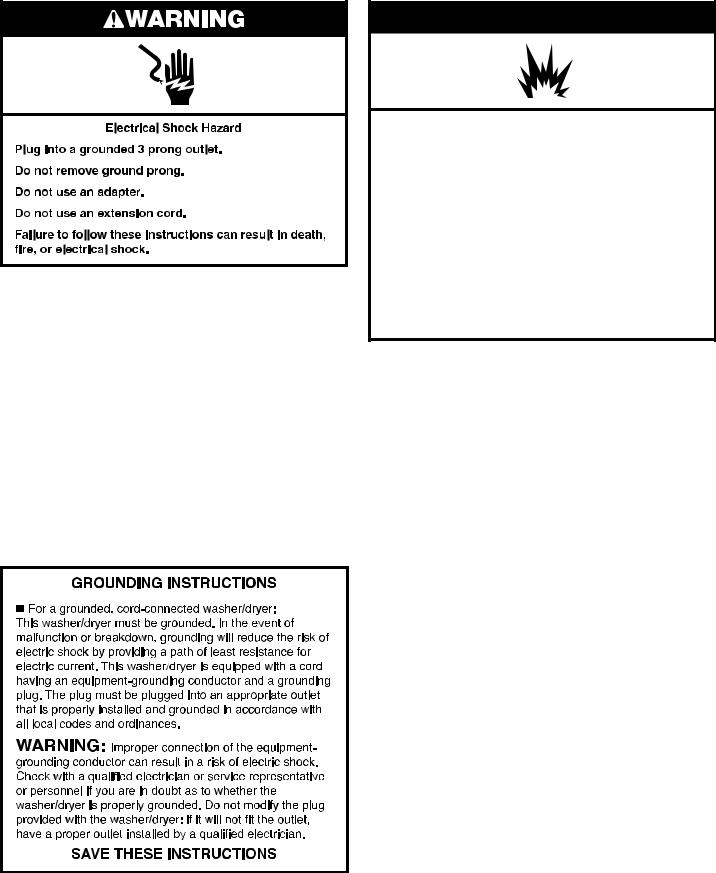
Electrical Requirements, Gas Models (27" [69 cm] Models Only)
nThis washer/dryer is equipped with a power supply cord having a 3-prong grounding plug.
nTo minimize possible shock hazard, the cord must be plugged into a mating, 3 prong, grounding-type outlet, grounded in accordance with local codes and ordinances. If a mating outlet is not available, it is the personal responsibility and obligation of the customer to have the properly grounded outlet installed by a qualified electrician.
nIf codes permit and a separate ground wire is used, it is recommended that a qualified electrician determine that the ground path is adequate.
nDo not ground to a gas pipe.
nCheck with a qualified electrician if you are not sure the washer/dryer is properly grounded.
nDo not have a fuse in the neutral or ground circuit.
n120 volt, 60 Hz, AC only, 15 or 20 amp fused electrical supply is required. A time-delay fuse or circuit breaker is recommended. It is also recommended that a separate circuit serving only this washer/dryer be provided.
Gas Supply Requirements, Gas Models (27" [69 cm] Models Only)
 WARNING
WARNING
Explosion Hazard
Use a new CSA International approved gas supply line. Install a shut-off valve.
Securely tighten all gas connections.
If connected to propane, have a qualified person make sure gas pressure does not exceed 13" (330 mm) water column.
Examples of a qualified person include:
licensed heating personnel,
authorized gas company personnel, and authorized service personnel.
Failure to do so can result in death, explosion, or fire.
GAS TYPE
Natural Gas:
This washer/dryer is equipped for use with natural gas. It is certified by UL for use with propane gas with appropriate conversion.
■■ Your washer/dryer must have the correct burner for the type of gas in your home. Burner information is located on the rating plate in the door well of your dryer. If this information does not agree with the type of gas available, contact
your dealer or call the phone numbers referenced in the “Assistance or Service” section of your Use and Care Guide.
Propane Gas Conversion:
IMPORTANT: Conversion must be made by a qualified technician.
No attempt shall be made to convert the appliance from the gas specified on the model/serial rating plate for use with a different gas without consulting your gas company.
13
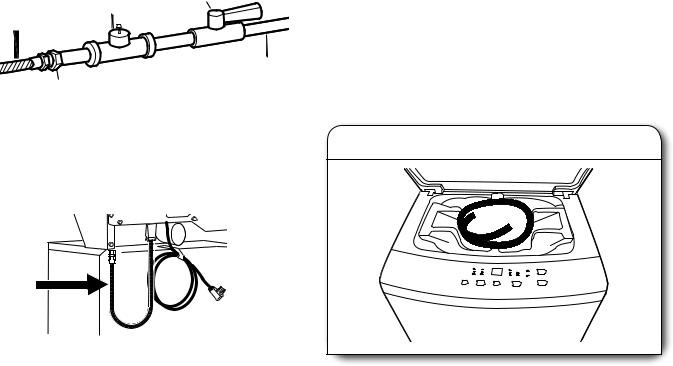
GAS SUPPLY LINE
■Must include 1/8" NPT minimum plugged tapping accessible for test gauge connection, immediately upstream of the gas connection to the washer/dryer. See illustration below.
■1/2" IPS pipe is recommended.
■Must include shut-off valve:
In the U.S.A.:
An individual manual shut-off valve must be installed within six (6) ft. (1.8 m) of the washer/dryer in accordance with the National Fuel Gas Code, ANSI Z223.1. The location should be easy to reach for opening and closing.
In Canada:
An individual manual shut-off valve must be installed in accordance with the B149.1, Natural Gas and Propane Installation Code. It is recommended that an individual manual shut-off valve be installed within six (6) ft. (1.8 m) of the washer/dryer. The location should be easy to reach for opening and closing.
E
C
A
D
B
A.3/8" fl exible gas connector
B.1/2" NPT adapter
C.1/8" NPT minimum plugged tapping
D.1/2" NPT gas supply line
E.Gas shut-off valve
This washer/dryer is equipped with its own permanent,
fl exible gas connector, design-certifi ed by CSA International, for connecting the washer/dryer to the gas supply line.
Flexible gas connector
DRYER GAS CONNECTION
Option 1
Rigid gas supply line:
■Connect your washer/dryer to the rigid gas supply line using the 1/2" NPT adapter between the gas supply line and the
fl exible gas connector on the washer/dryer.
Option 2
Approved aluminum or copper tubing:
■3/8" approved aluminum or copper tubing is acceptable for lengths under 20 ft. (6.1 m) if local codes and gas supplier permit.
■If you are using natural gas, do not use copper tubing.
■Lengths over 20 ft. (6.1 m) should use larger tubing and a different size adapter fi tting.
■If your washer/dryer has been converted to use propane gas, 3/8" propane compatible copper tubing can be used. If the total length of the supply line is more than 20 ft. (6.1 m), use larger pipe.
NOTE: Pipe-joint compounds that resist the action of propane gas must be used. Do not use TEFLON®† tape.
†®TEFLON is a registered trademark of Chemours.
GAS SUPPLY CONNECTION REQUIREMENTS
■Use the 1/2" NPT adapter between the gas supply line and the fl exible gas connector on the washer/dryer.
■Use only pipe-joint compound. Do not use TEFLON® tape.
BURNER INPUT REQUIREMENTS
Elevations up to 10,000 ft (3,048 meters):
■The design of this washer/dryer is certifi ed by CSA International for use at altitudes up to 10,000 ft (3,048 m) above sea level at the Btu rating indicated on the model/serial number plate. Burner input adjustments are not required when the washer/dryer is operated up to this elevation.
Elevations above 10,000 ft (3,048 meters):
■When installed above 10,000 ft. (3,048 m), a 4% reduction of the burner Btu rating shown on the model/serial number plate is required for each 1,000 ft. (305 m) increase in elevation.
Gas supply pressure testing
■The washer/dryer must be disconnected from the gas supply piping system during pressure testing at pressures greater than 1/2 psi.
Remove Foam Packing (24" [61 cm] models)
1. Pull foam packing ring out of washer
Open the washer lid. The latch under the dryer will keep the lid open. Pull the foam packing ring and drain hose out of the washer.
NOTE: Keep the foam ring and use it when transporting your washer/dryer. This packing material is used to keep the washer tub stable during transport.
14

Electrical Connection, 27" (69 cm) Electric Models (U.S.A. Only)
Power Supply Cord |
|
Direct Wire |
|
|
|
|
|
|
|
|
|
|
|
|
|
|
|
|
|
|
|
|
|
|
|
|
|
|
|
|
|
|
|
Fire Hazard |
|
|
|
|
|
|
|
|
|
|
|
|
|
|
|
|
|
|
|
|
|
|
Use 10 gauge copper wire. |
|
|
|
|
|
|
|
|
|
|
|
|
|
|
|
|
|
|
|
|
|
||
|
|
|
|
|
|
|
|
|
|
|
|
|
|
|
|
|
|
|
|
|
|
Use a UL listed strain relief. |
|
|
|
|
|
|
|
|
|
|
|
|
|
|
|
|
|
|
|
|
|
||
|
|
|
|
|
|
|
|
|
|
|
|
|
|
|
|
|
|
|
|
|
|
Disconnect power before making electrical connections. |
|
|
|
|
|
|
|
|
|
|
|
|
|
|
|
|
|
|
|
|
|
||
|
|
|
|
|
|
|
|
|
|
|
|
|
|
|
|
|
|
|
|
|
|
Connect neutral wire (white or center wire) to center |
|
|
|
|
|
|
|
|
|
|
|
|
|
|
|
|
|
|
|
|
|
|
terminal. |
|
|
|
|
|
|
|
|
|
|
|
|
|
|
|
|
|
|
|
|
|
||
|
|
|
|
|
|
|
|
|
|
|
|
|
|
|
|
|
|
|
|
|
|
Ground wire (green or bare wire) must be connected |
|
|
|
|
|
|
|
|
|
|
|
|
|
|
|
|
|
|
|
|
|
||
|
|
|
|
|
|
|
|
|
|
|
|
|
|
|
|
|
|
|
|
|
|
to green ground connector. |
|
|
|
|
|
|
|
|
|
|
|
|
|
|
|
|
|
|
|
|
|
|
Connect remaining 2 supply wires to remaining |
|
|
|
|
|
|
|
|
|
|
|
|
|
|
|
|
|
|
|
|
|
|
2 terminals (gold). |
|
|
|
|
|
|
|
|
|
|
|
|
|
|
|
|
|
|
|
|
|
||
|
|
|
|
|
|
|
|
|
|
|
|
|
|
|
|
|
|
|
|
|
||
|
|
|
|
|
|
|
|
|
|
|
|
|
|
|
|
|
|
|
|
|
|
Securely tighten all electrical connections. |
|
|
|
|
|
|
|
|
|
|
|
|
|
|
|
|
|
|
|
|
|
|
|
|
|
|
|
|
|
|
|
|
|
|
|
|
|
|
|
|
|
|
|
|
||
|
|
|
|
|
|
|
|
|
|
|
|
|
|
|
|
|
|
|
|
|
|
Failure to do so can result in death, re, or |
|
|
|
|
|
|
|
|
|
|
|
|
|
|
|
|
|
|
|
|
|
|
|
|
|
|
|
|
|
|
|
|
|
|
|
|
|
|
|
|
|
|
|
|
||
|
|
|
|
|
|
|
|
|
|
|
|
|
|
|
|
|
|
|
|
|
|
electrical shock. |
|
|
|
|
|
|
|
|
|
|
|
|
|
|
|
|
|
|
|
|
|
||
|
|
|
|
|
|
|
|
|
|
|
|
|
|
|
|
|
|
|
|
|
|
|
|
|
|
|
|
|
|
|
|
|
|
|
|
|
|
|
|
|
|
|
|
|
|
Electrical Connection Options |
|
|
||||||||||||||||||||
1. Choose electrical connection type |
|
2. Remove terminal block cover |
||||||||||||||||||||
Power supply cord 4-wire receptacle |
B |
C |
D A |
(NEMA Type 14-30R): Go to “4-Wire |
|
|
|
Power Supply Cord Connection.” |
|
|
|
Then, go to “Venting Requirements.” |
|
|
|
Power supply cord 3-wire receptacle |
|
|
|
(NEMA Type 10-30R): Go to “3-Wire |
|
|
|
Power Supply Cord Connection.” |
|
|
E |
Then go to “Venting Requirements.” |
|
|
|
|
|
|
|
|
|
|
F |
4-wire direct connection: Go to “4-Wire |
|
Direct Wire Connection.” Then go to |
|
“Venting Requirements.” |
Before you start, disconnect power. Remove hold-down |
|
screw (D) and terminal block cover (A). |
3-wire direct connection: Go to “3-Wire |
A. Terminal block cover |
B. External ground conductor screw |
|
Direct Wire Connection.” Then go to |
C. Center terminal block screw |
“Venting Requirements.” |
D. Hold-down screw |
|
E. Neutral ground wire |
NOTE: If local codes do not permit connection of a |
F. Hole below terminal block cover |
|
|
cabinet-ground conductor to neutral wire, go to “Optional |
|
3-Wire Connection.” This connection may be used with |
|
either a power supply cord or a direct wire connection. |
|
15

Power Supply Cord Connection
Power Supply Cord Strain Relief
1. Attach power supply cord strain relief
A |
B |
C |
D |
Remove the screws from a 3/4" (19 mm) UL Listed strain relief. Put the tabs of the two clamp sections (C) into the hole below the terminal block opening (B) so that one tab is pointing up (A) and the other is pointing down (D), and hold in place. Tighten strain relief screws just enough to hold the two clamp sections (C) together.
2. Attach power supply cord to strain relief
Put power supply cord through the strain relief. Be sure that the wire insulation on the power supply cord is inside the strain relief. The strain relief should have a tight fi t with the dryer cabinet and be in a horizontal position. Do not further tighten strain relief screws at this point.
If your outlet looks like this:
Power supply cord 4-wire receptacle (NEMA Type 14-30R):
Go to “4-Wire Power Supply Cord Connection” on this page.
Power supply cord 3-wire receptacle (NEMA Type 10-30R):
Go to “3-Wire Power Supply Cord Connection” on page 17.
4-Wire Power Supply Cord Connection
IMPORTANT: A 4-wire connection is required for mobile homes and where local codes do not permit the use of 3-wire connections.
4-wire receptacle (NEMA type 14-30R)
Spade terminals with upturned ends
4 prong plug
Ring terminals
1. Prepare to connect neutral ground wire and neutral wire
E |
B |
A |
Remove center terminal block screw (B). Remove neutral ground wire (E) from external ground conductor screw (A).
2. Connect neutral ground wire and neutral wire
E |
B |
C |
Connect neutral ground wire (E) and neutral wire (white or center) (C) of power supply cord under center terminal block screw (B). Tighten screw.
16
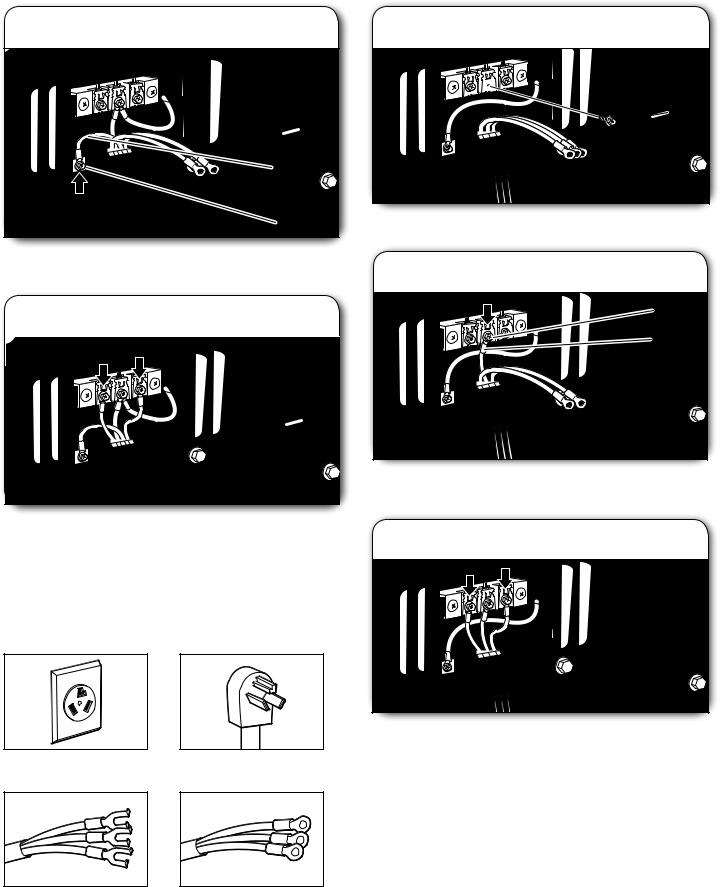
3. Connect ground wire
F |
A |
Connect ground wire (F) (green or bare) of power supply cord to external ground conductor screw (A). Tighten screw.
4. Connect remaining wires
1. Remove center screw
B |
Remove center terminal block screw (B).
2. Connect neutral wire
B
C
Connect remaining wires to outer terminal block screws. Tighten screws. Finally, reinsert tab of terminal block cover into slot of dryer rear panel. Secure cover with hold-down screw. Now, go to “Venting Requirements.”
3-Wire Power Supply Cord Connection
IMPORTANT: Use where local codes permit connecting cabinet-ground conductor to neutral wire.
Connect neutral wire (white or center) (C) of power supply cord to center terminal block screw (B). Tighten screw.
3. Connect remaining wires
3-wire receptacle (NEMA type 10-30R)
Spade terminals with upturned ends
3 prong plug
Ring terminals
Connect remaining wires to outer terminal block screws. Tighten screws. Finally, reinsert tab of terminal block cover into slot of dryer rear panel. Secure cover with hold-down screw. Now, go to “Venting Requirements.”
17

Direct Wire Connection
Direct Wire Strain Relief
1. Attach direct wire strain relief
A
B

 C
C
Unscrew the removable conduit connector (A) and any screws from a 3/4" (19 mm) UL Listed strain relief. Put the threaded section of the strain relief (C) through the hole below the terminal block opening (B). Reaching inside the terminal block opening, screw the removable conduit connector (A) onto the strain relief threads.
2. Attach direct wire cable to strain relief
Put direct wire cable through the strain relief. The strain relief should have a tight fi t with the dryer cabinet and be in a horizontal position. Tighten strain relief screw against the direct wire cable.
If your wiring looks like this:
4-wire direct wire connection:
Go to “4-Wire Direct Wire Connection” on this page.
3-wire direct wire connection:
Go to “3-Wire Direct Wire Connection” on page 19.
4-Wire Direct Wire Connection
IMPORTANT: A 4-wire connection is required for mobile homes and where local codes do not permit 3-wire connections.
1. Prepare your 4-wire cable for direct connection
|
|
1" |
|
|
(25 |
mm) |
|
|
|
||
(127 |
5" |
) |
|
|
|
||
mm |
|
||
|
|
||
Direct wire cable must have 5 ft. (1.52 m) of extra length so washer/dryer may be moved if needed.
Strip 5" (127 mm) of outer covering from end of cable, leaving bare ground wire at 5" (127 mm). Cut 1½" (38 mm) from remaining 3 wires. Strip insulation back 1" (25 mm). Shape ends of wires into hooks.
2. Prepare to connect neutral ground wire and neutral wire
E |
B |
A |
Remove center terminal block screw (B). Remove neutral ground wire (E) from external ground conductor screw (A).
18

3. Connect neutral ground wire and neutral wire
B |
E |
C |
Connect neutral ground wire (E) and place hooked end (hook facing right) of neutral wire (white or center wire) (C) of direct wire cable under center screw of terminal block (B). Squeeze hooked ends together and tighten screw.
4. Connect ground wire
F
A
3-Wire Direct Wire Connection
IMPORTANT: Use where local codes permit connecting cabinet-ground conductor to neutral wire.
1. Prepare your 3-wire cable for direct connection
1" |
|
(25 |
mm) |
|
|
3½" |
|
(89 |
mm) |
|
|
Direct wire cable must have 5 ft. (1.52 m) of extra length so washer/dryer may be moved if needed.
Strip 3½" (89 mm) of outer covering from end of cable. Strip insulation back 1" (25 mm). If using 3-wire cable with ground wire, cut bare wire even with outer covering. Shape wire ends into hooks.
2. Remove center screw



 B
B
Connect ground wire (green or bare) (F) of direct wire cable to external ground conductor screw (A). Tighten screw.
Remove center terminal block screw (B).
5. Connect remaining wires
Place hooked ends of remaining direct wire cable wires under outer terminal block screws (hooks facing right). Squeeze hooked ends together and tighten screws. Finally, reinsert tab of terminal block cover into slot of dryer rear panel. Secure cover with hold-down screw. Now, go to “Venting Requirements.”
19

3. Connect neutral wire
B |
C |
Place hooked end of neutral wire (white or center) (C) of direct wire cable under center terminal block screw (B). Squeeze hooked end together. Tighten screw.
4. Connect remaining wires
2. Connect neutral ground wire and neutral wire
B |
E |
C |
Connect neutral ground wire (E) and neutral wire (white or center wire) (C) of power supply cord or cable under center terminal block screw (B). Tighten screw.
3. Connect remaining wires
Place hooked ends of remaining direct wire cable wires under outer terminal block screws (hooks facing right). Squeeze hooked ends together and tighten screws. Finally, reinsert tab of terminal block cover into slot of dryer rear panel. Secure cover with hold-down screw. Now, go to “Venting Requirements.”
Optional 3-Wire Connection
IMPORTANT: You must verify with a qualifi ed electrician that this grounding method is acceptable before connecting.
1. Prepare to connect neutral ground wire and neutral wire
E
 B
B
 A
A
Remove center terminal block screw (B). Remove neutral ground wire (E) from external ground conductor screw (A).
Place remaining wires under outer terminal block screws (hooks facing right). Tighten screws.
4. Connect external ground wire
A
G
Connect a separate copper ground wire (G) from the external ground conductor screw (A) to an adequate ground. Finally, reinsert tab of terminal block cover into slot of dryer rear panel. Secure cover with hold-down screw. Now, go to “Venting Requirements.”
20

Electrical Connection, 24" (61 cm) 240V Electric Models (U.S.A. Only)
Power Supply Cord
Electrical Connection Options
1. Choose electrical connection type 2. Remove terminal block cover
Power supply cord 4-wire receptacle (NEMA Type 14-30R): Go to “4-Wire Power Supply Cord Connection.” Then, go to “Venting Requirements.”
Power supply cord 3-wire receptacle (NEMA Type 10-30R): Go to “3-Wire Power Supply Cord Connection.” Then go to “Venting Requirements.”
NOTE: If local codes do not permit connection of a cabinet-ground conductor to neutral wire, go to “Optional 3-Wire Connection.”
A |
B |
Before you start, disconnect power. Remove hold-down screw (B) and terminal block cover (C).
A.Center terminal block screw
B.Hold-down screw
C.Terminal block cover
D.External ground conductor screw
21
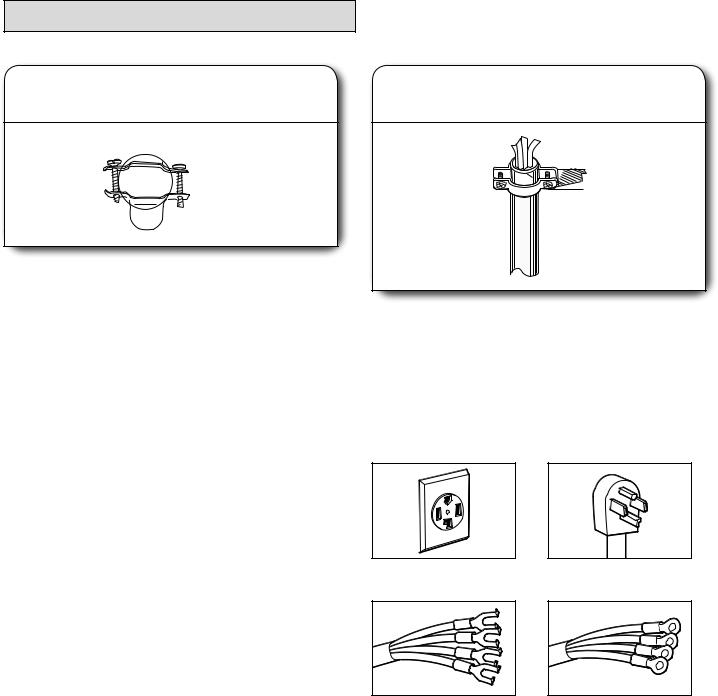
Power Supply Cord Connection
Power Supply Cord Strain Relief
1. Attach power supply cord strain relief
 A
A
 B
B
 C
C
 D
D
Remove the screws from a 3/4" (19 mm) UL Listed strain relief. Put the tabs of the two clamp sections (C) into the hole below the terminal block opening (B) so that one tab is pointing up (A) and the other is pointing down (D), and hold in place. Tighten strain relief screws just enough to hold the two clamp sections (C) together.
A.Strain relief tab pointing up
B.Hole below terminal block opening
C.Clamp section
D.Strain relief tab pointing down
2. Attach power supply cord to strain relief
Put power supply cord through the strain relief. Be sure that the wire insulation on the power supply cord is inside the strain relief. The strain relief should have a tight fi t with the dryer cabinet and be in a horizontal position. Do not further tighten strain relief screws at this point.
4-Wire Power Supply Cord Connection
IMPORTANT: A 4-wire connection is required for mobile homes and where local codes do not permit the use of 3-wire connections.
4-wire receptacle (NEMA type 14-30R)
Spade terminals with upturned ends
4 prong plug
Ring terminals
22
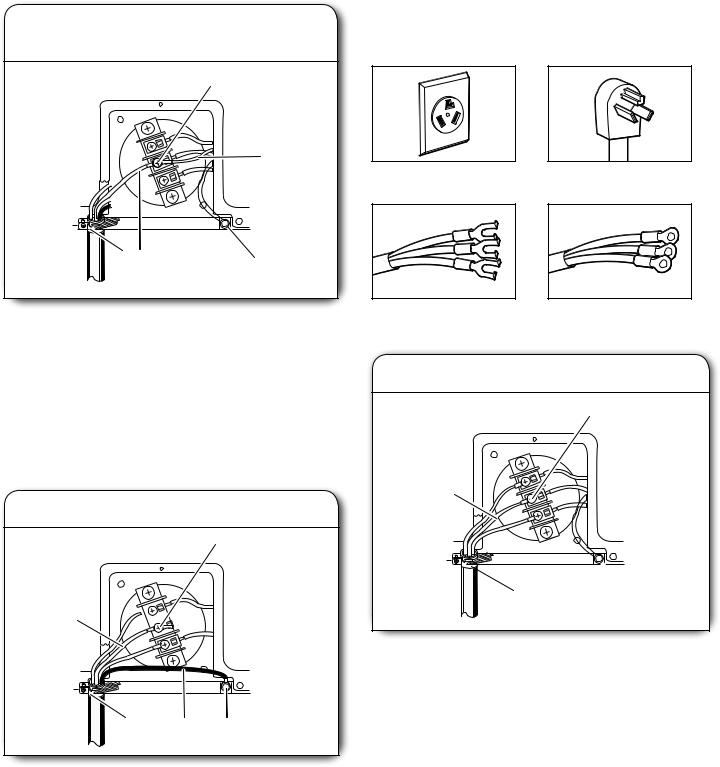
1. Connect neutral ground wire and neutral wire
|
A |
|
B |
E D |
C |
Remove center terminal block screw. Remove neutral ground wire from external ground conductor screw. Connect neutral ground wire and the neutral wire (white or center wire)
of power supply cord under center terminal block screw. Tighten screw.
A.Center terminal block screw
B.Neutral ground wire
C.External ground conductor screw – Dotted line shows position of NEUTRAL ground wire before being moved to center terminal block screw.
D.Neutral wire (white or center wire)
E.3/4" (19 mm) UL Listed strain relief
2.Connect ground wire
B
A 

 C
C
F E D
Connect ground wire (green or bare) of power supply cord to external ground conductor screw. Tighten screw.
A.Neutral wire (white or center wire)
B.Center terminal block screw
C.Neutral ground wire
D.External ground conductor screw
E.Ground wire (green or bare) of power supply cord
F.3/4" (19 mm) UL Listed strain relief
Connect the other wires to outer terminal block screws. Tighten screws. Tighten strain relief screws. Insert tab of terminal block cover into slot of dryer rear panel. Secure cover with hold-down screw. Now go to “Venting Requirements.”
3-Wire Power Supply Cord Connection
IMPORTANT: Use where local codes permit connecting cabinet-ground conductor to neutral wire.
3-wire receptacle (NEMA type 10-30R)
Spade terminals with upturned ends
3 prong plug
Ring terminals
1. Connect neutral wire
B
A
 C
C
 E
E  D
D
Loosen or remove center terminal block screw. Connect neutral wire (white or center wire) of power supply cord to the center terminal screw of the terminal block. Tighten screw.
A.Neutral wire (white or center wire)
B.Center terminal block screw
C.Neutral ground wire
D.External ground conductor screw
E.3/4" (19 mm) UL Listed strain relief
Connect the other wires to outer terminal block screws. Tighten screws. Tighten strain relief screws. Insert tab of terminal block cover into slot of dryer rear panel. Secure cover with hold-down screw. Now go to “Venting Requirements.”
23

Optional 3-Wire Connection
Use for power supply cord where local codes do not permit connecting cabinet-ground conductor to neutral wire.
1. Connect neutral ground wire and neutral wire
2. Connect remaining wires and connect separate ground wire
A


 B
B
 C
C
D 
Remove center terminal block screw. Remove neutral ground wire from external ground conductor screw. Connect neutral ground wire and the neutral wire (white or center wire) of power supply cord under center terminal block screw. Tighten screw.
A.Neutral wire (white or center wire)
B.Neutral ground wire
C.External ground conductor screw – Dotted line shows position of NEUTRAL ground wire before being moved to center terminal block screw.
D.Grounding path determined by a qualifi ed electrician
Connect the other wires to outer terminal block screws. Tighten screws. Tighten strain relief screws. Connect a separate copper ground wire from the external ground conductor screw to an adequate ground. Insert tab
of terminal block cover into slot of dryer rear panel. Secure cover with hold-down screw. Now go to “Venting Requirements.”
24

Venting
Venting Requirements
Exhaust hoods:
■■Must be at least 12" (305 mm) from ground or any object that may obstruct exhaust (such as flowers, rocks, bushes, or snow).
Recommended Styles:
WARNING: To reduce the risk of fire, this dryer MUST BE EXHAUSTED OUTDOORS.
IMPORTANT: Observe all governing codes and ordinances. Dryer exhaust must not be connected into any gas vent, chimney, wall, ceiling, attic, crawlspace, or a concealed space of a building. Only rigid or flexible metal vent shall be used for exhausting.
4" (102 mm)
4" (102 mm) heavy metal exhaust vent
■■Only a 4" (102 mm) heavy metal exhaust vent and clamps may be used.
■■Do not use plastic or metal foil vent.
Rigid metal vent:
■■Recommended for best drying performance and to avoid crushing and kinking.
Flexible metal vent: (Acceptable only if accessible to clean) ■■Must be fully extended and supported in final dryer location.
■■Remove excess to avoid sagging and kinking that may result in reduced airflow and poor performance.
■■Do not install in enclosed walls, ceilings, or floors. ■■The total length should not exceed 7¾ ft. (2.4 m).
NOTE: If using an existing vent system, clean lint from entire length of the system and make sure exhaust hood is not plugged with lint. Replace plastic or metal foil vents with rigid metal
or flexible metal vents. Review “Vent System Chart” and, if necessary, modify existing vent system to achieve best drying performance.
Louvered hood |
Box hood |
Acceptable Style:
Angled hood
Elbows:
■■45° elbows provide better airflow than 90° elbows.
Good |
Better |
Clamps:
■■Use clamps to seal all joints.
■■Exhaust vent must not be connected or secured with screws or other fastening devices that extend into interior of duct and catch lint. Do not use duct tape.
See “Venting Kits” for more information.
25
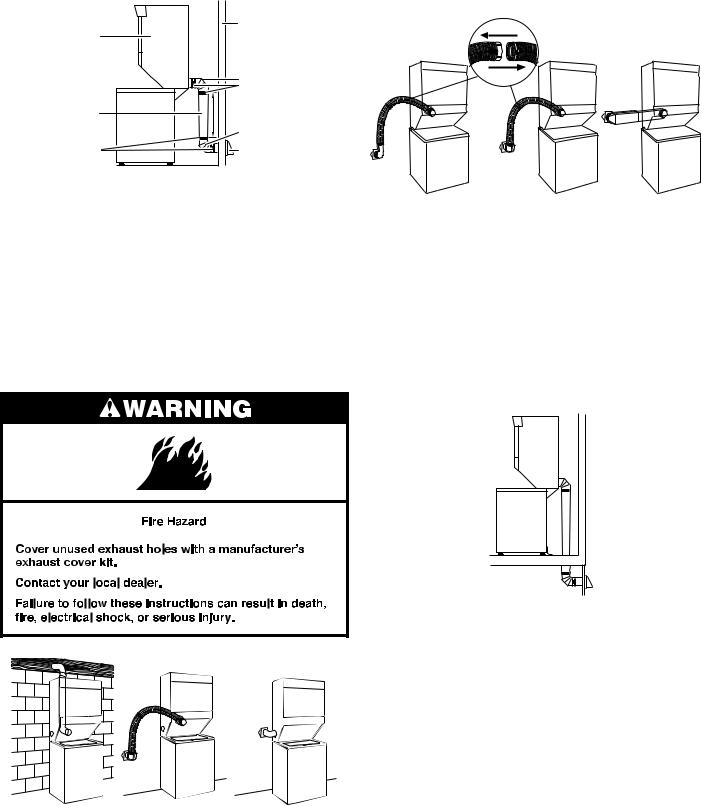
Plan Vent System
Recommended exhaust installations
Typical installations vent the washer/dryer from the rear. Other installations are possible.
A |
D |
|
|
|
E |
|
F |
B |
|
|
G |
C |
H |
A. Dryer |
E. Elbow |
B. Rigid metal or flexible metal vent |
F. Clamps |
C. Clamps |
G. Elbow |
D. Wall |
H. Exhaust hood |
Optional exhaust installations:
24" (61 cm) washer/dryer models can be converted to exhaust out the right or left side. To convert the washer/dryer, use Side Exhaust Kit Part Number 279823. If your washer/dryer was previously exhausted from the right or left side, it can be
converted to rear exhaust by using standard offset connections. To cover the hole in the side, the following plug can be added:
692790 (white)
Follow the instructions in the kit to install. The kit is available from the dealer from whom you purchased your washer/dryer.
A B C
A.Standard rear offset exhaust installation
B.Rear exhaust for offset close-clearance connection
C.Leftor right-side exhaust installation (24" [61 cm] models only)
Alternate installations for close clearances
Venting systems come in many varieties. Select the type best for your installation. Three close-clearance installations are shown. Refer to the manufacturer’s instructions.
A B C
A.Loop system with standard elbows
B.Loop system with one offset and one standard elbow
C.Vent system with one periscope (2" [51 mm] clearance)
Venting Kits
For more information, call 1-866-698-2538, or visit us
at www.whirlpool.com. In Canada, call 1-800-688-2002 or visit us at www.whirlpool.ca.
Special provisions for mobile home installations:
The exhaust vent must be securely fastened to a noncombustible portion of the mobile home structure and must not terminate beneath the mobile home. Terminate the exhaust vent outside.
Determine vent path:
■■ Select route that will provide straightest and most direct path outdoors.
■■ Plan installation to use fewest number of elbows and turns.
■■ When using elbows or making turns, allow as much room as possible.
■■ Bend vent gradually to avoid kinking. ■■ Use as few 90° turns as possible.
26
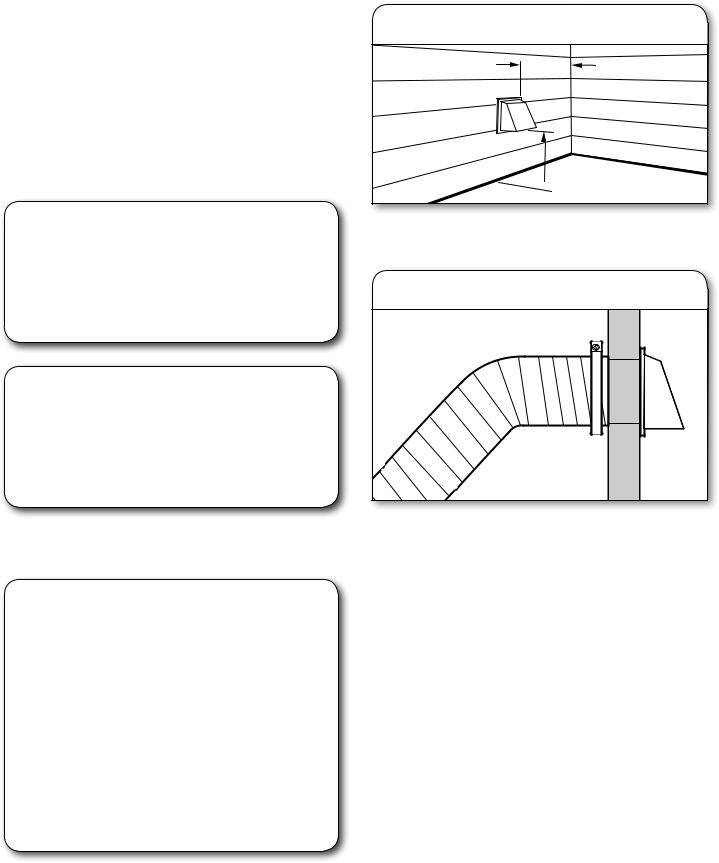
Determine vent length and elbows needed for best drying performance:
νUse following Vent System Chart to determine type of vent material and hood combinations acceptable to use.
NOTE: Do not use vent runs longer than those specifi ed in Vent System Chart. Exhaust systems longer than those specifi ed will:
νShorten life of dryer.
νReduce performance, resulting in longer drying times and increased energy usage.
The Vent System Chart provides venting requirements that will help achieve best drying performance.
Vent System Chart, 27" (69 cm) Models
Number of 90° |
Type |
Angled |
turns or elbows |
of vent |
hoods |
|
|
|
0 |
Rigid metal |
35 ft. (10.7 m) |
|
|
|
1 |
Rigid metal |
27 ft. (8.2 m) |
|
|
|
2 |
Rigid metal |
19 ft. (5.8 m) |
|
|
|
Vent System Chart, 24" (61 cm) Models
Number of 90° |
Type |
Angled |
turns or elbows |
of vent |
hoods |
|
|
|
0 |
Rigid metal |
36 ft. (11.0 m) |
|
|
|
1 |
Rigid metal |
26 ft. (7.9 m) |
|
|
|
2 |
Rigid metal |
16 ft. (4.9 m) |
|
|
|
NOTE: Side exhaust installations (24" [61 cm] models only) have a 90º turn inside the dryer. To determine maximum exhaust length, add one 90º turn to the chart.
Vent System Chart,
27" (69 cm) Long Vent Models WETLV27H and WGTLV27H (U.S. Only)
Number of |
Type |
Angled |
90° turns |
of vent |
hoods |
or elbows |
|
|
0 |
Rigid metal |
125 ft. (38.1 m) |
|
|
|
1 |
Rigid metal |
115 ft. (35.1 m) |
|
|
|
2 |
Rigid metal |
105 ft. (32.0 m) |
|
|
|
3 |
Rigid metal |
95 ft. (29.0 m) |
|
|
|
4 |
Rigid metal |
85 ft. (25.9 m) |
|
|
|
5 |
Rigid metal |
75 ft. (22.9 m) |
|
|
|
Install Vent System
1. Install exhaust hood
12" min.
(305 mm)
12" min.
 (305 mm)
(305 mm)
Install exhaust hood and use caulking compound to seal exterior wall opening around exhaust hood.
2. Connect vent to exhaust hood |
Vent must fi t inside the exhaust hood. Secure vent to exhaust hood with 4" (102 mm) clamp. Run vent to dryer location using straightest path possible. Avoid 90° turns. Use clamps to seal all joints. Do not use duct tape, screws, or other fastening devices that extend into interior of vent to secure vent, because they can catch lint.
27

Connect Drain Hose
Proper connection of the drain hose protects your fl oors from damage due to water leakage. To keep the drain hose from coming off or leaking, it must be installed according to the following instructions:
IMPORTANT: To ensure proper installation, this procedure must be followed exactly.
1. Attach clamp to drain hose
1/4"¼" 

 ((6..4 mm)
((6..4 mm)
Check the drain hose to see whether it is the proper length. Wet the inside of the straight end of the drain hose with tap water.
IMPORTANT: Do not use any lubricant other than water.
Squeeze ears of the silver double-wire clamp with pliers to open. Place clamp over the straight end of the drain hose 1/4" (6.4 mm) from the end.
2. Attach drain hose to drain connector (27" [69 cm] model shown)
The |
24" (61 cm) model will vary |
Open clamp. Twist hose back and forth while pushing onto drain connector at the lower left (27" [69 cm] models) or lower center (24" [61 cm] models) portion of the rear of the washer/ dryer. Continue until hose contacts the ribbed stops on the cabinet. On 27" (69 cm) models, place clamp over the area on the hose marked “CLAMP.” On 24" (61 cm) models, place
clamp over the smooth area on the hose between the two ribs. Release clamp.
3. Place drain hose in standpipe
Drain hose form
4.5"  (114 mm)
(114 mm)
Place hose into standpipe (shown in picture) or over side of laundry tub.
IMPORTANT: 4.5" (114 mm) of drain hose should be inside standpipe; do not force excess hose into standpipe or lay on bottom of laundry tub. Drain hose form must be used.
4. Remove drain hose form (floor drain installations only)
For fl oor drain installations, you will need to remove the drain hose form from the end of the drain hose. You may need additional parts with separate directions. See “Tools and Parts.”
28
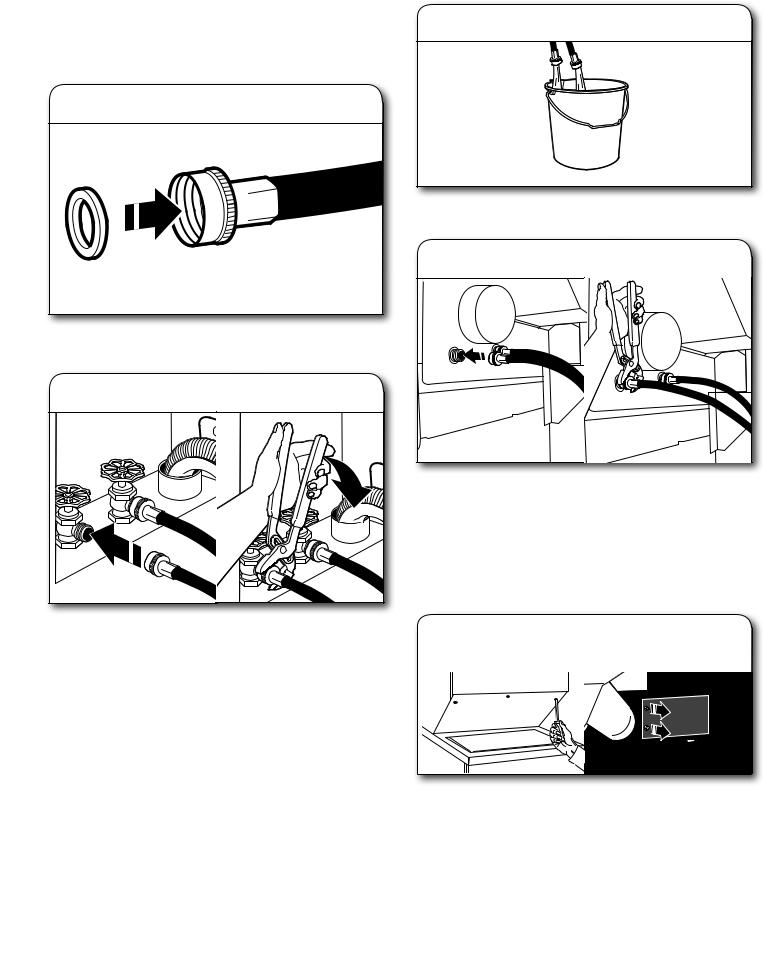
Connect Inlet Hoses
Washer must be connected to water faucets with new inlet hoses with fl at washers (not provided). Do not use old hoses.
NOTE: Both hoses must be attached and have water fl owing to inlet valves. If you are only connecting to a cold water faucet, you must use a Y-adapter (not included).
1. Insert washer into each hose
Washer |
Coupling |
Insert a new fl at washer into each end of the inlet hoses (not provided). Firmly seat the washers in the couplings.
2. Connect inlet hoses to water faucets |
Attach hose to hot water faucet. Screw on coupling by hand until it is seated on washer. Use pliers to tighten couplings an additional two-thirds turn. Repeat this step with second hose for cold water faucet.
IMPORTANT: Do not overtighten or use tape or sealants on valve when attaching to faucets or washer. Damage can result.
HELPFUL TIP: Make note of which hose is connected to hot water to help in attaching hoses to washer correctly. In most standard confi gurations, hoses will cross over each other when attached correctly.
3. Clear water lines
Run water for a few seconds through hoses into a laundry tub, drainpipe, or bucket to prevent clogs. Water should run until clear.
4. Connect inlet hoses to washer
Attach hot water hose to the right-hand (red) inlet valve. Screw coupling by hand until it is snug. Use pliers to tighten couplings an additional two-thirds turn. Repeat with cold water inlet valve (left-hand [blue] inlet valve).
IMPORTANT: To reduce risk of hose failure, replace the hoses every 5 years. Record hose installation or replacement dates for future reference.
νPeriodically inspect and replace hoses if bulges, kinks, cuts, wear, or leaks are found.
5. Move washer/dryer to final location
|
Outer Access Panel |
|
Inner Access Panel |
(27" [69 cm] model shown) |
|
(27" [69 cm] models only) |
|
|
|||
|
|
|
|
If you are working in a closet or recessed area: move the washer/dryer into its fi nal location and remove cardboard from under washer/dryer. Remove the outer access panel by removing two (24" [61 cm] models) or three (27" [69 cm] models) Phillips-head screws and one bumper (27" [69 cm]
models only), located at the top of the access panel. Remove inner access panel (27" [69 cm] models only) by removing cover and two screws. Set panels, screws, inner access panel cover, and bumper aside. Complete hookup of water hoses and vent. Replace access panels upon completion of
washer/dryer installation.
29
